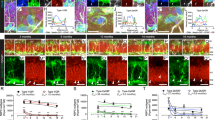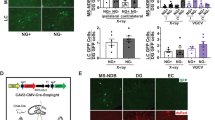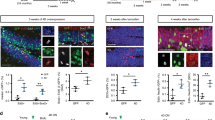Abstract
The production of hippocampal granule neurons continues throughout adulthood but dramatically decreases in old age. Here we show that reducing corticosteroid levels in aged rats restored the rate of cell proliferation, resulting in increased numbers of new granule neurons. This result indicates that the neuronal precursor population in the dentate gyrus remains stable into old age, but that neurogenesis is normally slowed by high levels of corticosteroids. The findings further suggest that decreased neurogenesis may contribute to age-related memory deficits associated with high corticosteroids, and that these deficits may be reversible.
This is a preview of subscription content, access via your institution
Access options
Subscribe to this journal
Receive 12 print issues and online access
$209.00 per year
only $17.42 per issue
Buy this article
- Purchase on Springer Link
- Instant access to full article PDF
Prices may be subject to local taxes which are calculated during checkout




Similar content being viewed by others
References
Vargha-Khadem, F. et al. Differential effects of early hippocampal pathology on episodic and semantic memory. Science 277, 376–380 (1997).
Nilsson, L.-G., Baeckman, L., Erngrund, K. & Nyberg, L. The Betula prospective cohort study: memory, health, and aging. Aging Neuropsychol. Cognit. 4, 1–32 (1997).
Sapolsky, R. M. Do glucocorticoid concentrations rise with age in the rat? Neurobiol. Aging 13, 171–174 ( 1992).
Lupien, S. et al. Basal cortisol levels and cognitive deficits in human aging. J. Neurosci. 14, 2893– 2903 (1994).
Lupien, S. J. et al. Cortisol levels during human aging predict hippocampal atrophy and memory deficits. Nat. Neurosci. 1, 69 –73 (1998).
Landfield, P. W. & Eldridge, J. C. The glucocorticoid hypothesis of age-related hippocampal neurodegeneration: role of dysregulated intraneuronal calcium. Ann. NY Acad. Sci. 746, 308–326 (1994).
Porter, N. M. & Landfield, P. W. Stress hormones and brain aging: adding injury to insult? Nat. Neurosci. 1, 3–4 (1998).
Cameron, H. A. & McKay, R. Stem cells and neurogenesis in the adult brain. Curr. Opin. Neurobiol. 8, 677 –680 (1998).
Eriksson, P. S. et al. Neurogenesis in the adult human hippocampus. Nat. Med. 4, 1313–1317 ( 1998).
Gould, E. et al. Hippocampal neurogenesis in adult Old World primates. Proc. Natl. Acad. Sci. USA 96, 5263– 5267 (1999).
Seki, T. & Arai, Y. Age-related production of new granule cells in the adult dentate gyrus. Neuroreport 6, 2479–2482 (1995).
Kuhn, H. G., Dickinson-Anson, H. & Gage, F. H. Neurogenesis in the dentate gyrus of the adult rat: age-related decrease of neuronal progenitor proliferation. J. Neurosci. 16, 2027–2033 ( 1996).
Gould, E., Woolley, C. S., Cameron, H. A., Daniels, D. C. & McEwen, B. S. Adrenal steroids regulate postnatal development of the rat dentate gyrus: II. Effects of glucocorticoids and mineralocorticoids on cell birth. J. Comp. Neurol. 313, 486 –493 (1991).
Cameron, H. A & Gould, E. Adult neurogenesis is regulated by adrenal steroids in the dentate gyrus. Neuroscience 61, 203–209 (1994).
Gould, E., McEwen, B. S., Tanapat, P., Galea, L. A. & Fuchs, E. Neurogenesis in the dentate gyrus of the adult tree shrew is regulated by psychosocial stress and NMDA receptor activation. J. Neurosci. 17, 2492– 2498 (1997).
Gould, E., Tanapat, P., McEwen, B.S, Flugge, G. & Fuchs, E. Proliferation of granule cell precursors in the dentate gyrus of adult monkeys is diminished by stress. Proc. Natl. Acad. Sci. USA 95, 3168– 3171 (1998).
Cameron, H. A., Woolley, C. S., McEwen, B. S. & Gould, E. Differentiation of newly born neurons and glia in the dentate gyrus of the adult rat. Neuroscience 56, 337– 344 (1993).
Gould, E., Woolley, C. S. & McEwen, B. S. Short-term glucocorticoid manipulations affect neuronal morphology and survival in the adult dentate gyrus. Neuroscience 37, 367–375 ( 1990).
Cameron, H. A. & Gould, E. Distinct populations of cells in the adult dentate gyrus undergo mitosis or apoptosis in response to adrenalectomy. J. Comp. Neurol. 369, 56–63 (1996).
Sloviter, R. S., Dean, E. & Neubort, S. Electron microscopic analysis of adrenalectomy-induced hippocampal granule cell degeneration in the rat apoptosis in the adult central nervous system. J. Comp. Neurol. 330, 337 –351 (1993).
Bye, N. & Nichols, N. R. Adrenalectomy-induced apoptosis and glial responsiveness during ageing. Neuroreport 9, 1179–1184 (1998).
Minturn, J. E., Geschwind, D. H., Fryer, H. J. & Hockfield, S. Early postmitotic neurons transiently express TOAD-64, a neural specific protein. J. Comp. Neurol. 355, 369– 379 (1995).
Seress, L. & Pokorny, J. Structure of the granular layer of the rat dentate gyrus. A light microscopic and Golgi study. J. Anat. 133, 181–195 ( 1981).
Debus, E., Weber, K. & Osborn, M. Monoclonal antibodies specific for glial fibrillary acidic (GFA) protein and for each of the neurofilament triplet polypeptides. Differentiation 25, 193–203 (1983).
Kosaka, T. & Hama, K. Three-dimensional structure of astrocytes in the rat dentate gyrus. J. Comp. Neurol. 249, 242–260 (1986).
Gould, E. & Tanapat, P. Lesion-induced proliferation of neuronal progenitors in the dentate gyrus of the adult rat. Neuroscience 80, 427–436 ( 1997).
Gould, E., Cameron, H. A., Daniels, D. C., Woolley, C. S. & McEwen, B. S. Adrenal hormones suppress cell division in the adult rat dentate gyrus. J. Neurosci. 12, 3642–3650 (1992).
Gould, E., Beylin, A., Tanapat, P., Reeves, A. & Shors, T. J. Learning enhances adult neurogenesis in the hippocampal formation. Nat. Neurosci. 2, 260– 265 (1999).
Kempermann, G., Kuhn, H. G. & Gage, F. H. Experience-induced neurogenesis in the senescent dentate gyrus. J. Neurosci. 18, 3206– 3212 (1998).
West, M. J. Regionally specific loss of neurons in the aging human hippocampus. Neurobiol. Aging 14, 287–293 (1993).
Rapp, P. R. & Gallagher, M. Preserved neuron number in the hippocampus of aged rats with spatial learning deficits. Proc. Natl. Acad. Sci. USA 93, 9926–9930 (1996).
Woolley, C. S., Gould, E. & McEwen, B. S. Exposure to excess glucocorticoids alters dendritic morphology of adult hippocampal pyramidal neurons. Brain Res. 531, 225–231 (1990).
Watanabe, Y., Gould, E., Cameron, H. A., Daniels, D. C. & McEwen, B. S. Phenytoin prevents stress- and corticosterone-induced damage of CA3 pyramidal neurons. Hippocampus 2, 431–436 ( 1992).
Magarinos, A. M., Deslandes, A. & McEwen, B. S. Effects of antidepressants and benzodiazepine treatments on the dendritic structure of CA3 pyramidal neurons after chronic stress. Eur. J. Pharmacol. 371, 113– 122 (1999).
Magarinos, A. M. & McEwen, B. S. Stress-induced atrophy of apical dendrites of hippocampal CA3c neurons: involvement of glucocorticoid secretion and excitatory amino acid receptors. Neuroscience 69, 89–98 (1995).
Liu, Y. B., Lio, P. A., Pasternak, J. F. & Trommer, B. L. Developmental changes in membrane properties and postsynaptic currents of granule cells in rat dentate gyrus. J. Neurophysiol. 76, 1074–1088 (1996).
West, M. J. New stereological methods for counting neurons. Neurobiol. Aging 14, 275–285 ( 1993).
Guillery, R. W. & Herrup, K. Quantification without pontification: Choosing a method for counting objects in sectioned tissues. J. Comp. Neurol. 386, 2– 7 (1997).
Acknowledgements
We thank Susan Hockfield for her gift of TOAD-64 antisera and Farnaz Yassaee and Bechien Wu for their technical assistance.
Author information
Authors and Affiliations
Corresponding author
Rights and permissions
About this article
Cite this article
Cameron, H., McKay, R. Restoring production of hippocampal neurons in old age. Nat Neurosci 2, 894–897 (1999). https://doi.org/10.1038/13197
Accepted:
Issue Date:
DOI: https://doi.org/10.1038/13197
This article is cited by
-
Aging Modulates the Ability of Quiescent Radial Glia-Like Stem Cells in the Hippocampal Dentate Gyrus to be Recruited into Division by Pro-neurogenic Stimuli
Molecular Neurobiology (2023)
-
Dissecting the role of adult hippocampal neurogenesis towards resilience versus susceptibility to stress-related mood disorders
npj Science of Learning (2022)
-
On inflammatory hypothesis of depression: what is the role of IL-6 in the middle of the chaos?
Journal of Neuroinflammation (2021)
-
Current understanding of adult neurogenesis in the mammalian brain: how does adult neurogenesis decrease with age?
Inflammation and Regeneration (2020)
-
Circadian glucocorticoid oscillations preserve a population of adult hippocampal neural stem cells in the aging brain
Molecular Psychiatry (2020)



